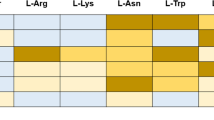Abstract
Glutamine-dependent amidotransferases have been known for more than 30 years. The mechanism by which these enzymes generate ammonia from the glutamine amide nitrogen and transfer it to seven different chemical classes of acceptors has been the subject of intense scrutiny for the last 5 years. The increasing number of biochemical and structural studies dealing with amidotransferases and with mechanistically related enzymes has disclosed the dichotomy of the mechanisms within these enzymes for achieving the glutamine amide bond cleavage. Some of them use a catalytic Cys/His/Glu triad similar to serine protease, whereas the aminoterminal cysteine of the others is believed to play the same function. The transfer of ammonia from the glutamine site to the acceptor site which must operate in a concerted manner has been demonstrated in two cases to involve channelling but is still matter of investigation.
Similar content being viewed by others
Author information
Authors and Affiliations
Rights and permissions
About this article
Cite this article
Massière, F., Badet-Denisot, MA. The mechanism of glutamine-dependent amidotransferases. CMLS, Cell. Mol. Life Sci. 54, 205–222 (1998). https://doi.org/10.1007/s000180050145
Published:
Issue Date:
DOI: https://doi.org/10.1007/s000180050145




